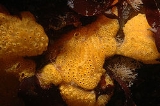
Botrylloides violaceus
Encyclopedia
Botrylloides violaceus is a colonial
tunicate
of the genus Botrylloides
. Its native range is the in Northwest Pacific from Southern China to Japan and Siberia.. Colonies attach and grow on solid surfaces and substrates, and consist of individuals arranged in twisting rows. Outside its native range, it is considered an invasive species and are becoming more common in coastal waters of North America and other waters around the world, likely being spread by shipping industries.
In the San Francisco Bay area, B. violaceus can be readily found on boat docks in the Richmond Marina. The ecology impact of B. viollaceus to this region remains unknown.
network of blood vessels that terminate in ampullae
(small sac-like structures) at the periphery of the colony. Their color varies
from bright orange to reddish or dull purple. These tunicates usually
have 8 branchial tentacles and 11 rows of stigmata.
Colony (biology)
In biology, a colony reference to several individual organisms of the same species living closely together, usually for mutual benefit, such as stronger defense or the ability to attack bigger prey. Some insects live only in colonies...
tunicate
Tunicate
Tunicates, also known as urochordates, are members of the subphylum Tunicata, previously known as Urochordata, a group of underwater saclike filter feeders with incurrent and excurrent siphons that is classified within the phylum Chordata. While most tunicates live on the ocean floor, others such...
of the genus Botrylloides
Botrylloides
The "Chain Sea Squirts or Chain Tunicates" of the genus Botrylloides:Morphologically similar to Botryllus schlosseri and similarly widespread, Botrylloides is distinguished by having linearly-arranged, parallel "chains" of zooids as opposed to zooids like white or yellow stripes emanating from a...
. Its native range is the in Northwest Pacific from Southern China to Japan and Siberia.. Colonies attach and grow on solid surfaces and substrates, and consist of individuals arranged in twisting rows. Outside its native range, it is considered an invasive species and are becoming more common in coastal waters of North America and other waters around the world, likely being spread by shipping industries.
In the San Francisco Bay area, B. violaceus can be readily found on boat docks in the Richmond Marina. The ecology impact of B. viollaceus to this region remains unknown.
Physical description
Zooids are embedded in a transparent tunic and are all connected to one another by anetwork of blood vessels that terminate in ampullae
(small sac-like structures) at the periphery of the colony. Their color varies
from bright orange to reddish or dull purple. These tunicates usually
have 8 branchial tentacles and 11 rows of stigmata.

